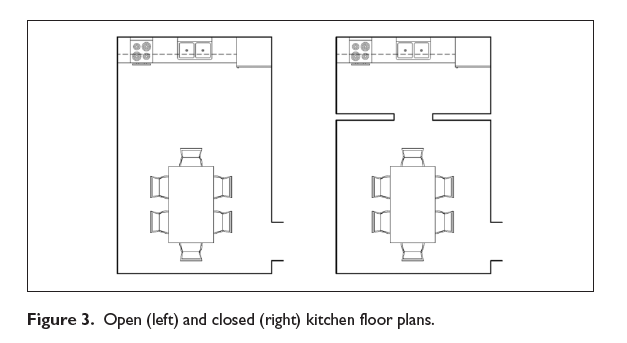Can seeing food in your kitchen and easy serving make a difference in how much you eat? A study authored by an architect and an environmental psychologist published this month suggests that may be an unintended outcome of the popular open kitchen design in homes.
That’s important because how many calories you eat affects your weight, and that affects cancer risk.
Published in Environment and Behavior the authors looked at how much the open plan – easy to see the food and get to the buffet – affected the amount of food participants (57 university students) ate, compared to a closed plan. For one dinner they ate in the open plan, for another they ate in the closed plan. They used a university food and dining research lab and made it mimic a closed plan by putting decorative wooden screens to block the diners’ view of food.
 The authors hid scales under the food on the buffet and weighed leftovers to calculate how much food students took and ate. Students were told they were in a study on group behavior.
The authors hid scales under the food on the buffet and weighed leftovers to calculate how much food students took and ate. Students were told they were in a study on group behavior.
Researchers measured the number of trips the students took to the buffet to serve themselves, how much they served themselves and how much they actually ate. Regardless of the floor plan, students who went back for more ate an additional 170 calories per trip. And when they dined in the open plan they made more extra trips than when dining in the closed plan. Overall those making extra trips ate about 36 more calories in the open than in the closed dining/kitchen area.

Researchers put screens between the table and kitchen to make it harder to see the food and less convenient to get to the kitchen
This shows one way your physical environment can influence what and how much you eat. If you have an open kitchen design though, you don’t need to remodel your house. You can make simple changes that help you and your family enhance healthy eating and discourage overeating.
Here are some tips so you can enjoy the open space without inadvertently overeating:
- Keep higher calorie foods covered and out of view from the dining room
- Put vegetables, green salads and other lower-calorie foods on the table or in sight to encourage eating filling up on cancer-protective foods.
- Downsize your dinner plates and bowls so you’ll eat smaller portion sizes.
- Remember to follow AICR’s New American Plate model for cancer prevention and healthy weight: 2/3 or more vegetables, whole grains, beans and other plant foods and 1/3 or less animal foods.
There’s still time to sign up for AICR’s free 12 week healthy weight program, the New American Plate Challenge.





